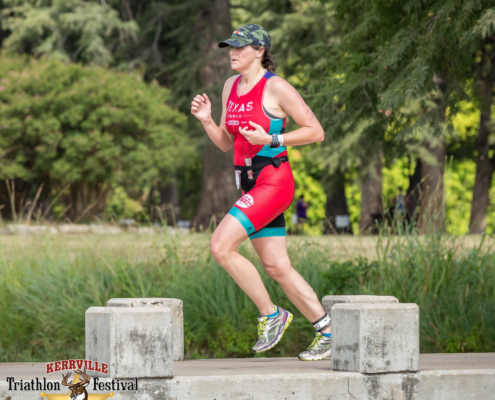Run softly you could take time off your run
As triathletes, it seems that the inherent beating our legs take while on training runs often leads to some of the most nagging and potentially severe injuries. That dreaded pain on the inside of a shin. The chronically inflamed IT band. A perpetually tight hamstring. The list goes on. Too many times we chalk this up as “part of the process.” What many athletes do not realize is that by applying a few subtle technique changes to running form, common injuries can be eradicated and running speed can be gained. By being quiet while you run you can achieve increased economy of movement; in other words, run softly.
While on your next training run for the Kerrville Tri, leave the iPod at home and prepare to listen while you run softly. Listen to your gait. Is there a heavy sigh from the ground on every foot strike? Do you notice a shuffling sound similar to autumn foliage moving along at the pace of a breeze? If you are picking up on sounds that are more audible than not, you may need to work on your foot strike and run more softly.
[bctt tweet=”When you run softly it allows your foot to strike the ground and transition from the initial contact This is often considered heel strike or a mid-foot strike, with less breaking force (ground reaction force).” username=”kerrvilletri”]
This means that less impact is transferred from this brief, but violent stop throughout your body. Think of a plane landing gently at an optimal angle. Now think of a plane landing that comes down a little hard and jolts the entire cabin. This is not entirely dissimilar to the jolt your body takes each time your foot lands. When coaches tell athletes to run with light feet, this is precisely what they are referring to.
On runs, occasionally think about foot strike and quick transition. As your heel comes in contact with the ground try to roll your foot forward to the mid-foot, then to the ball of your foot, and then to a strong, propulsive toe-off. Work on doing this seamlessly and without interruption. Another important key to this skill is never allowing heel strike to be forward of your knee. Your heel strike should occur directly under your knee and your knee should be directly beneath your center of gravity. Look down while in heel strike to mid-stance of your stride. At that point, you should see no more than the tips of your toes extending from beneath your knee. If you see more than just the tips, then you’re creating a greater ground reaction force and more resistance – increasing your risk for injury.
[bctt tweet=”Like anything, running softly takes time to develop. Remind yourself to run softly because the impact can be huge.” username=”kerrvilletri”]

